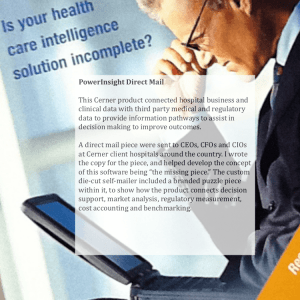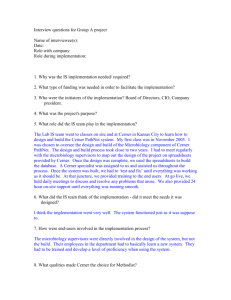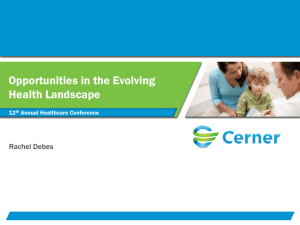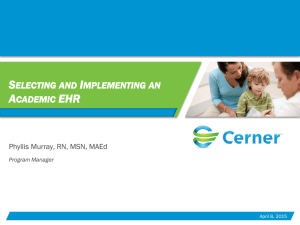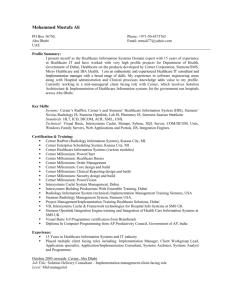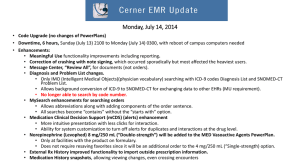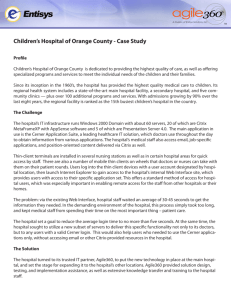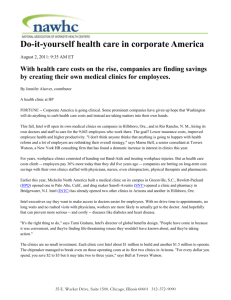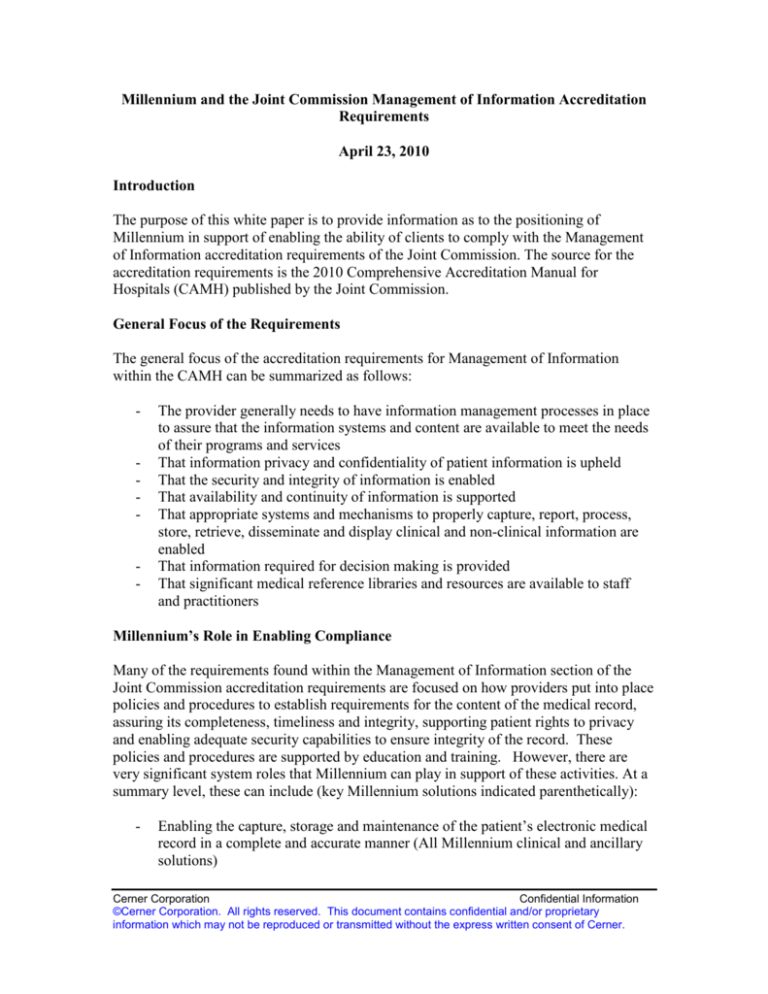
Millennium and the Joint Commission Management of Information Accreditation
Requirements
April 23, 2010
Introduction
The purpose of this white paper is to provide information as to the positioning of
Millennium in support of enabling the ability of clients to comply with the Management
of Information accreditation requirements of the Joint Commission. The source for the
accreditation requirements is the 2010 Comprehensive Accreditation Manual for
Hospitals (CAMH) published by the Joint Commission.
General Focus of the Requirements
The general focus of the accreditation requirements for Management of Information
within the CAMH can be summarized as follows:
-
-
-
The provider generally needs to have information management processes in place
to assure that the information systems and content are available to meet the needs
of their programs and services
That information privacy and confidentiality of patient information is upheld
That the security and integrity of information is enabled
That availability and continuity of information is supported
That appropriate systems and mechanisms to properly capture, report, process,
store, retrieve, disseminate and display clinical and non-clinical information are
enabled
That information required for decision making is provided
That significant medical reference libraries and resources are available to staff
and practitioners
Millennium’s Role in Enabling Compliance
Many of the requirements found within the Management of Information section of the
Joint Commission accreditation requirements are focused on how providers put into place
policies and procedures to establish requirements for the content of the medical record,
assuring its completeness, timeliness and integrity, supporting patient rights to privacy
and enabling adequate security capabilities to ensure integrity of the record. These
policies and procedures are supported by education and training. However, there are
very significant system roles that Millennium can play in support of these activities. At a
summary level, these can include (key Millennium solutions indicated parenthetically):
-
Enabling the capture, storage and maintenance of the patient’s electronic medical
record in a complete and accurate manner (All Millennium clinical and ancillary
solutions)
Cerner Corporation
Confidential Information
©Cerner Corporation. All rights reserved. This document contains confidential and/or proprietary
information which may not be reproduced or transmitted without the express written consent of Cerner.
-
-
-
-
-
Supporting access controls to limit access to and use of a patient’s electronic
medical record to authorized individuals in a manner appropriate to the roles of
such individuals in providing care or supporting care (NOTE: This is a general
statement relative to both Millennium Authentication and Authorization Security
and the access controls present in non-Millennium solutions integrated with
Millennium such as PowerInsight)
Providing systems of audit to capture accesses to electronic medical records in
order to enforce and provide accountability to the privacy and security policies of
a provider (Millennium Audit Services and P2 Sentinel)
Supporting continuous availability of the patient’s electronic medical record with
disaster recovery and business continuity capabilities to sustain access during
business interruptions and emergencies (Disaster Recovery/Business Continuity
Services from Cerner Technology, Failover processes and Transaction Recovery
from Application and Technical Architecture, PowerChart 7x24 Access from
Cerner TechWorks, Remote Hosting Services from CernerWorks)
Providing validation capabilities of data entered into the electronic medical record
based on use of code set values, required field entry rules, reference ranges,
format validity rules and other methods (Core capability common to all solutions)
Supporting required data entry parameters in forms design to assure completeness
of entry (Core capability common to all solutions)
At a more granular level, Millennium can assist in enabling compliance with the
Management of Information requirements in the following ways (NOTE: Specific Joint
Commission accreditation requirements are stated followed by the abilities of Millennium
to enable compliance). The Joint Commission requirements that are highlighted for
comment are those that seem to most directly imply a system role in compliance.
IM.01.01.03 – The hospital plans for continuity of its information management processes
-
-
The hospital has a written plan for managing interruptions to its information
processes
The hospital’s plan for managing interruptions to information processes
addresses the following: Scheduled and unscheduled interruption of electronic
information systems, training for staff and LIPs on alternative procedures to
follow when electronic information systems are unavailable, backup of electronic
information systems
The hospital’s plan for managing interruptions to electronic information
processes is tested for effectiveness according to time frames defined by the
organization
The system enables an overall business continuity strategy that includes solutions to
manage for the automated rollover of the system to standing redundant hardware and
software in case of unscheduled interruptions due to critical component failure in a
production system. This capability includes the ability to log and replay transactions
necessary to assure timely and complete recovery from an interruption of service of
this kind. An overall strategy is recommended to implement a redundant
Cerner Corporation
Confidential Information
©Cerner Corporation. All rights reserved. This document contains confidential and/or proprietary
information which may not be reproduced or transmitted without the express written consent of Cerner.
configuration all the way across the board from network to processor to database to
servers. A remote recovery site is recommended that is off site to the primary
computing facility to guard against the loss of a primary site should the outage be of a
more complete variety that not only may threaten component level failure but total
system outage for a primary facility. Remote system management services are also
offered to help enable this.
For shorter periods of planned and unplanned downtime, patient data access can be
enabled for the end user in a read-only mode to allow for planned maintenance of the
system where a complete failover to a DR system is not feasible or necessary. This
functionality assumes only portions of the system will be unavailable. In the event of
a short downtime where more of the required infrastructure is not available or the
Network is unavailable, local applications can be run even in the absence of
connectivity to the application services of the main system. For more extended
periods of downtime, technologies and mechanisms such as those discussed above are
recommended tactics for mitigating such downtime.
Cerner provides recommendations for the testing of business continuity/disaster
recovery plans that involve the system.
The system is capable of running backups while the system is operational – Cerner
has upgraded its software installation tools to minimize system disruption due to code
introduction – Cerner uses capabilities like 724Access Downtime Viewer and
724Access Read-Only to allow for access to the clinical data during scheduled
downtimes, and Cerner provides environment management tools to help provide for
efficient code and reference or activity data management during scheduled downtime.
Cerner provides clients with recommended back up procedures for normal scheduled
backups whether of a daily, weekly or periodic nature.
See white paper on Millennium and the Joint Commission Environment of Care
requirements for additional information.
•
The hospital implements its plan for managing interruptions to information
processes to maintain access to information needed for patient care
Through its Immediate Response Center (IRC) and through its remote facilities
management services, Cerner provides support to clients that have to implement their
business continuity/disaster recovery plan should the situation arise. More
information on these services and capabilities may be had by contacting Cerner
Technologies.
Relative to Cerner’s remote hosting services provided through CernerWorks,
disruption to a contracted service. A fully redundant, N+1 Infrastructure is utilized for
all Production environments hosted at CernerWorks Data Centers. Two separate
telecommunication providers are used to provide diverse network paths from the
client site to the CernerWorks Data Center. (Some clients may have elected not to
Cerner Corporation
Confidential Information
©Cerner Corporation. All rights reserved. This document contains confidential and/or proprietary
information which may not be reproduced or transmitted without the express written consent of Cerner.
have some of the redundant Infrastructure components in an effort to reduce costs.
This affects their service availability in the case of an interruption of service). System
backups are conducted in compliance with the CTC Backup Procedure or Enterprise
Backup Procedure (utilizing the EMC Networker solution) to provide a method to
restore a system in case of a disaster.
In the event there are multiple failures of the same component type (e.g. both
redundant network switches are disrupted) CernerWorks will make commercially
reasonable efforts to repair or replace the failed components and return the affected
service(s) to normal operation. Should an event occur that precludes delivery of
contracted services for an extended period of time, a business continuity/disaster
recovery (BCDR) plan will be activated. Quarterly BCDR testing includes executing
the emergency mode operating plan, retrieval of media from off-site location,
restoration of client environments at a second facility, and redirection of
telecommunications as needed. Restoration precedence is based on analysis of several
factors including data criticality and is available to contracted clients on request. The
plan is regularly reviewed and updated as needed by CernerWorks personnel, and test
documentation is audited by Regulatory Affairs and the CernerWorks Compliance
Specialist to ensure compliance.
For client-hosted clients Cerner Technologies can assist in the system integration of
Cerner’s backup strategies with Enterprise backup solutions if desired.
IM.02.01.01 – The hospital protects the privacy of health information
-
The hospital implements its policy on the privacy of health information
The hospital discloses health information only as authorized by the patient or as
otherwise consistent with law and regulation
The hospital uses health information only for purposes as required by law and
regulation and as further limited by its policy on privacy
The system provides a variety of disclosure log mechanisms for outputs from the
electronic health record maintained by Millennium whether through clinical
reporting, remote web access, output events done by end users or other means. Much
of this logging is enabled through Millennium’s core audit services for logging to P2
Sentinel, and some of it is enabled for disclosure logging through Clinical Reporting
XR (or its legacy equivalent, Clinical Reporting WIN32).
The system helps assure the privacy of identifiable patient information through its
security mechanisms that require a specifically identified user to successfully
authenticate to the system in order to then be an authorized user of system resources.
The authentication can be performed by a variety of mechanisms including advanced
authentication techniques such as by biometrics. Initial levels of capability to enable
single sign-on between Millennium and other solutions intended for integrated use
with Millennium such as PowerInsight or P2 Sentinel (access audit solution) is in
process, and capabilities to authenticate to external user directories also are available.
Cerner Corporation
Confidential Information
©Cerner Corporation. All rights reserved. This document contains confidential and/or proprietary
information which may not be reproduced or transmitted without the express written consent of Cerner.
The authorization policies supported by the access control module of the system
provide for role based application task access, and for both role and user based data
access to patient encounters and clinical data within encounters. The access control
capabilities also enable limiting user accesses to certain organizations and locations
within organizations appropriate to user need to know (e.g. by patient location) and to
work areas where the user is assigned to work (e.g. service resources as performing
work sites). User abilities to search for patients in the system can be wholly
constrained through task security or limited to those patients who have been admitted
or registered to provider organizations where the user is on staff and authorized to
access patient records.
Specific confidential conditions on particular patient data implemented in support of
patient requested restrictions for “seals” on data or for protecting classes of
information required to be so protected by statute are dependent either on limiting
authorized accesses to users in care providing roles with access to specific data types
on a need to know basis or based upon the ability to identify affected “confidential”
encounters within which the affected data resides. Additionally, the system does
support denial of access to the electronic medical record for a specific patient from
access by a named user. This restriction can be implemented at the person level.
Aside from that, the system does not offer the ability at present to mark specific parts
of an individual patient record as protected from access (or that are subject to specific
grants of access) by certain named individuals or roles.
Also, as a general rule, the application tasks in the system have been designed to
display information about specific types of clinical data, and with patient
demographics appropriate to the purpose at hand. On line forms and formatted
structured output of clinical data can also generally be designed to be limited to the
purpose of the form or output.
Relative to printing information for clinical use out of Clinical Reporting, the system
supports the ability of a user to print clinical information to be consistent with the
user’s online access rights to patient information. Within Clinical Reporting, sensitive
result sections can be identified, and as applied to release of information from the
electronic medical record, when a user goes to print, the user has to both have
security to access the sensitive data online and then to be able select them for
printing. For normal clinical report distributions done through operations, the system
enables printing what is called for by the relevant clinical report format at hand.
Relative to Cerner’s remote hosting services provided through CernerWorks, Cerner’s
Protection of Patient Information standard operating procedure outlines proper
methods for viewing, handling, printing, transmitting and disposing of patient
information from workstations or other access devices to ensure the privacy and
confidentiality of the information. Workstation security is accomplished using a
combination of safeguards that includes both physical restriction and control to the
facility as well as technical safeguards such as intrusion detection, anti-virus
software, firewalls and password management. In order to meet regulatory and
Cerner Corporation
Confidential Information
©Cerner Corporation. All rights reserved. This document contains confidential and/or proprietary
information which may not be reproduced or transmitted without the express written consent of Cerner.
contractual requirements relating to privacy and security, Cerner is obligated to
require that all Associates handle patient information appropriately. It is Cerner’s
mandatory policy that Associates must ensure the proper use of patient information as
we assist our clients in implementing, supporting and hosting their information
systems. This means that Cerner Associates and Consultants must not engage in any
activity that may inappropriately use or disclose protected health information. Failure
to comply with this requirement will result in sanction, up to and including
termination of employment/service agreement.
To assure privacy of information that is disclosed where identifiable information is
not required, the system supports development of extracts and reports through its
report writer capabilities to output information in the appropriate format per the
reporting requirement. The system also enables pseudonymization (through
HealthFacts) and anonymization (through PowerInsight) of patient identifiers in
support of data aggregation needs for analytical purposes. PowerInsight also supports
reporting of aggregated data if that is the basis of need. The system also can enable
any identifying patient information to be effectively screened out, and apply security
to prevent access to identifiable patient data from within a reporting context.
When the need for identifiable patient information to fulfill a release of information
request is specified, the system also supports release of information management
capabilities to distinguish types of release requests, and the patient authorization
requirements for given types of releases. The system can require that indication that
patient authorization has been obtained be documented before proceeding with
release of information for particular types of releases.
•
The hospital monitors compliance with its policy on the privacy of health
information
See response to IM.02.01.03 below for audit capabilities available within the system
and through P2 Sentinel to enable audit of compliance with the privacy policies of the
hospital.
IM.02.01.03 – The hospital maintains the security and integrity of health information
-
The hospital monitors compliance with its policies on the security and integrity of
health information
The hospital protects against unauthorized access, use and disclosure of health
information
See response to IM.02.01.01 above for information on access control capabilities to
support authorized access to personal health information.
For enforcing the security and privacy policies of the hospital, the system enables the
recording of accesses to a patient’s electronic medical record thus supporting holding
users of a patient’s electronic information accountable for their activities. Such
Cerner Corporation
Confidential Information
©Cerner Corporation. All rights reserved. This document contains confidential and/or proprietary
information which may not be reproduced or transmitted without the express written consent of Cerner.
accesses may include both activities to create or maintain information in the patient’s
record as well as activities to inquire into or output information from the patient’s
record. The system makes available the audit trail of such accesses for transmission to
externally maintained audit log systems for retention and analysis. The audit system
(called P2 Sentinel) made available to accompany Millennium implementations
enables both predefined and ad hoc queries into audit data of this kind as well as
alerting of appropriate privacy or security officers or auditors on a real time basis
should suspect access conditions occur.
-
The hospital protects health information against loss, damage, unauthorized
alteration, unintentional change and accidental destruction
The hospital controls the intentional destruction of health information
The system enables encryption technologies to be used for protection of the integrity
of patient data that is communicated or stored electronically. Among these
capabilities are the abilities to:
•
•
•
Protect information used during an end user session through session encryption
available through Citrix
Protect information communicated electronically across a network for clients
hosted by Cerner’s CernerWorks application service hosting facility using
encryption available in the IPSec VPN
Protect information for data stored in Cerner’s CernerWorks application service
hosting facility and for off line storage using encryption capabilities available
through the Storage Area Network (SAN) technologies used by Cerner
The system also enables implementation of secure configurations that include
components designed to guard against unauthorized intrusion that may result in data
corruption, damage or loss. The system is typically operated behind a firewall or on a
closed network or virtual private network if a local installation. When the system is
hosted by Cerner, it is hosted behind a secure firewall with secure communications
supported by Transport Layer Security (TLS) and with secure sessions served up by
Citrix. Beyond this, unauthorized access is mitigated by the authentication and
authorization capabilities of the security architecture of the system that requires users
to be specifically identified and authenticated before being allowed to access system
resources, and to only be able to access system resources (and patient records) in an
authorized manner as understood by the access control capabilities of the system. As
to more technical security measures enabled around the system, the system enables
application of security components to assure a secure configuration of the desktop,
operating system and backend, and to maintain currency with new releases of such
capabilities relative to those components. Sound system management and change
management practices are recommended to ensure that only certified system
components are installed in production environments after they have been subjected
to verification in test environments.
Cerner Corporation
Confidential Information
©Cerner Corporation. All rights reserved. This document contains confidential and/or proprietary
information which may not be reproduced or transmitted without the express written consent of Cerner.
The system makes use of registered application service requests, and the system’s
application services only recognize requests from client applications that make use of
one of the registered service requests. When the system is sent a message from a
different system, the system makes use of device authentication to support message
acknowledgment for interfacing so as to assure exchange of information with a
trusted source or destination.
The system also can leverage secure communication capabilities present in network
communication protocols to assure message integrity for information in transit (such
as by use of Secure Socket Layer/Transport Layer Security based encryption). The
system can make use of virtual private networks (VPNs) to enable closing a network
from public access to mitigate unauthorized intrusion. The system also supports use
of session encryption for Citrix based sessions as well as for the audit system used for
tracking accesses to the electronic medical record.
Relative to Cerner’s remote hosting services provided through CernerWorks, Each
client is responsible for the integrity of the content, while Cerner manages the
integrity of the systems on which data resides. Cerner has written policies for
addressing information security that is based on and consistent with law or regulation.
Cerner develops and implements controls to safeguard data and information,
including the clinical record, against loss, destruction, and tampering using a
combination of authentication, authorization, encryption, and backups. System
logging provides trails to ensure only authorized individuals actually access a patient
record.
IM.02.02.01 – The hospital effectively manages the collection of health information
•
•
The hospital uses uniform data sets to standardize data collection throughout the
hospital
The hospital uses standardized terminology, definitions, abbreviations, acronyms,
symbols and dose designations
The system also supports use of standardized abbreviations, acronyms and medical
vocabularies where and when appropriate to the mode of documentation entry to be
used in clinical documentation entry, physician note entry or diagnostic result entry
(e.g. such as with the use of American College of Radiology BI-RADS (Breast
Imaging Reporting and Data System) codes for Mammography). This helps facilitate
standardized entry for required elements of documentation especially where the
collection, retrieval and analysis of such data is required to be in standardized
meanings and forms to ease such analysis. The system generally enables reporting of
management information appropriate to the different patient care units/departments,
ancillary areas and administrative functions supported by system applications. These
include reporting of activity levels by period, by provider, by shift, acuity levels (on a
similar basis as for activity) and turnaround time measures appropriate to a given
domain (e.g. order to clinical report for lab procedures, door to triage, door to
Cerner Corporation
Confidential Information
©Cerner Corporation. All rights reserved. This document contains confidential and/or proprietary
information which may not be reproduced or transmitted without the express written consent of Cerner.
discharge, etc for the ED). In the ED, this information can be presented through
graphical views of information in addition to as reports.
The system supports definition of “do not use” abbreviations, acronyms and symbols
for reference in medication management, physician documentation entry and order
management.
Cerner provides recommended starting sets of reference data content for most every
major type of reference data or code set used by the system. This content embodies
required or industry standard code sets such as common medical code sets (CPT,
ICD9, HCPCS, SNOMED CT, LOINC, NDC codes and the like) as well as nonmedical code sets (ANSI X-12, UB04) for administrative reference data. The content
also includes reference data starter sets for key reference data tables such as the order
catalog, the formulary, the charge master and for registration forms, labels of all
kinds, claims/billing formats, and all manners of system configuration settings to ease
the implementation process.
Cerner also provides an ability to map medical code sets to a common code set value
called a concept CKI (Cerner Knowledge Index).
For lab values, Cerner allows for mapping of General Lab, Microbiology as of
August of 2009 and mapping for Blood Bank results will be available in 2011. As
results post to the Clinical Events table, a reference service will associate the
appropriate LOINC term to the result in the Clinical Event activity data structure so
that the system can enable outbound interfacing using LOINC codes. This will help
enable eventual support for HIPAA Claims Attachment requirements by providing
the appropriate LOINC reference context for fulfilling the requirements of the HL7
Clinical Document Architecture (CDA) specification for the document types
proposed for HIPAA Claims Attachments. Cerner can also post SNOMED CT values
to organisms for Microbiology results.
For nursing documentation, the system supports use of standardized code sets with
mapping of evidence based nursing concepts to standard code sets. Clients can also
map in external nursing documentation standards if they wish to Cerner’s starter
content or build the mapping out on their own for use in Cerner’s nursing
documentation forms.
IM.02.02.03 – The hospital retrieves, disseminates and transmits health information in
usable formats
-
The hospital has written policies for addressing data capture, display,
transmission and retention
The hospital’s storage and retrieval systems make health information accessible
when needed for patient care
Cerner Corporation
Confidential Information
©Cerner Corporation. All rights reserved. This document contains confidential and/or proprietary
information which may not be reproduced or transmitted without the express written consent of Cerner.
The system enables definition of entry; format and data type requirements for the
capture of patient information whether through the definition of registration
conversations, the design of clinical documentation templates used for assessments,
result entry validation rules for entry of discrete clinical results and other
mechanisms. The system supports appropriate processing and storage of patient
information to fit the workflow requirements of the particular care process at hand.
For example, the system can create scheduled nursing tasks as generated from a care
plan that is associated to a patient encounter. This in turn drives the scheduling and
completion of nursing activities which can be charted against the assigned nursing
tasks. The options for entry for completion of such tasks are defined to support the
requirements of the particular type of entry at hand. The information can then be
stored as discrete data available for inclusion in nursing documentation and progress
notes and used for on line reference or output to care providers that need to be able to
make reference to nursing documentation. Patient electronic information is
maintained in a real time manner for any updates to the record, and this information is
accessible to users on a similar basis as long as in final verified forms as a general
rule. In process information may only be accessible to those clinicians and staff
responsible for its entry and completion. When clinical information is in such a form,
it is instantly available to other care team members, staff and clinicians in that form
on line, and can be output to clinical reports for distribution in other forms than as on
line as may be required. Clinical report formats can be defined to reflect what is
necessary for proper reporting of the result, and distributions can be defined for both
printing and faxing to allow for accurate report distribution. Information that is not
necessary for long term retention (such as in process data) may be subject to purging,
but information necessary for long term retention can be retained on line and/or
archived as may be appropriate.
The system supports secure transmission of data in support of transaction processing
through the use of registered application services (see discussion earlier in this white
paper on security capabilities of the system), and through support for the use of
private networks or closed networks for supporting secure network communications
whether as locally implemented or as hosted by Cerner.
The system supports retention of data for periods of time sufficient to comply with
statutory or regulatory requirements. Cerner is working on more flexible archive
capabilities to allow this to be finer grained, but most clients elect to retain the more
permanent forms of patient data indefinitely in the on line medical record with “in
process’ activity data tables purged according to more short term information
retention policies.
-
The hospital disseminates data and information in useful formats within time
frames that are defined by the hospital and consistent with law and regulation
For clinical result reporting, the system enables definition of clinical report formats
and distributions appropriate to the type of clinical report at hand, and supportive to
the need to distribute reports to the appropriate audiences directly involved in the
Cerner Corporation
Confidential Information
©Cerner Corporation. All rights reserved. This document contains confidential and/or proprietary
information which may not be reproduced or transmitted without the express written consent of Cerner.
patient’s care such as to the ordering physician, the patient location where the patient
may be roomed as an inpatient, to the ordering location associated to a given
diagnostic test order and to other output destinations associated to end clinical report
recipients such as in physician offices. The clinical report formats use standard
reference data infrastructure to provide for appropriate formatting of demographic
and clinical information about the patient significant to the type of clinical data at
hand.
Clinical reporting (particularly for diagnostic results for lab values and diagnostic
radiology reports) can be generated considering the priority of the diagnostic test
order, and the recipient can be notified of the results availability if appropriate
through messaging to specific physician “inboxes” or to tracking boards (such as in
the ED). TAT reporting is available to manage the service levels of diagnostic
departments as is discussed in the white paper Millennium and JC Provision of Care
Accreditation Requirements and under National Patient Safety Goal 2 in the white
paper Millennium and JC NPSG Requirements.
The concept CKI provides assistance to map clinical concepts across medical
vocabularies, and to assure consistent meaning at a common level for reference data
that may be tagged with site specific labels, mnemonics or display values. These help
assure that when data is aggregated from multiple sources into the electronic medical
record that the data can be seen as holding consistent meaning. This also is key to the
system capability to enable the capture and codification of regulatory or quality
related data important to quality measurement or outcomes measurement along with
operational reporting and interoperability.
For management reporting, the system’s enterprise reporting solution, PowerInsight
leverages the concept mapping defined with Millennium to assure reliable consistent
meaning for data. PowerInsight was designed to externalize decision support data
from the Millennium transactional domain into a separate domain which enabled reformatting of the data into a schema that more adequately supported processorintensive queries, retrospective analysis and summary-level reporting. Many reports
are created and provided through PowerInsight. These reports provide the ability to
study Key Performance Indicators (KPI) and other items of interest. KPIs are high–
level metrics that provide an organizational view of the selected data. They are an
intersection of a time dimension (last month) and a measure (mortality) that provides
the user with a view into the current state of a particular aspect of the organization.
The end user is provided access to predefined reports as well as the ability to produce
their own ad hoc queries. Additionally, as data marts are added to the solution, new
reports will be added.
See also the discussions about outcomes measurement contained in the Millennium
and JC Leadership Accreditation Requirements whitepaper . Cerner can support
ongoing monitoring within the context of a process of continuous engagement with
Lighthouse. This includes provision of updates to recommended guidelines and
outcome benchmarks used in evaluating performance on an ongoing basis.
Cerner Corporation
Confidential Information
©Cerner Corporation. All rights reserved. This document contains confidential and/or proprietary
information which may not be reproduced or transmitted without the express written consent of Cerner.
System also enables benchmarking for certain quality data through HealthFacts
solution (see whitepaper on Millennium and the Joint Commission Performance
Improvement Accreditation Requirements for more information). PowerInsight
supports definition of an external benchmark for use in analysis which can come from
that provided by Health Facts or from another external source identified by the
provider.
Relative to performance improvement, see discussion on process modeling and
outcomes monitoring in the white paper Millennium and JC Leadership Accreditation
Requirements.
Relative to infection control and patient safety incident related reporting, the system
may be a data source for those, but risk management and infection control types of
reporting are not typically driven directly from the system.
IM.03.01.01 – Knowledge based information resources are available, current and
authoritative
•
The hospital provides access to knowledge based information resources 24 hours
a day, 7 days a week
The system enables reference to on line reference libraries and medical literature as
appropriate to certain contexts. As two examples - Reference to Multum information
is enabled for support of the medication management process. Access to physician
reference materials is enabled through the Powerchart. References to the underlying
literature review citations are also available in the context of expert decision support
rules applied to clinical events such as orders when there are contraindications
present. Clients may also use these capabilities to maintain their own reference links
to on line resources.
For those clients supported by Cerner’s remote hosting services through
CernerWorks, Cerner performs regular updates to the drug interaction database
supported by Multum on a monthly basis.
For mental health services, online links are not made available as a part of the
predefined recommended content – there is some reference text that can be made
available on the PowerForms as to the significance of the need to document particular
information – but reference text is not widely provided with Cerner’s recommended
content.
For nursing, the system generally supports access to online knowledge resources
through hyperlinks or through enabling a web browser to be launched from within
Powerchart. Clients can also link in their own intranet resources as desired through
links from within the nursing application. Any Cerner provided links are maintained
as a part of the START database.
Cerner Corporation
Confidential Information
©Cerner Corporation. All rights reserved. This document contains confidential and/or proprietary
information which may not be reproduced or transmitted without the express written consent of Cerner.
For physicians, the system enables a URL to be embedded in a physician note, and
users can access the reference data behind the URL contained within a physician note.
For those references provided by Cerner as content, the URLs are maintained on an
annual basis.
IM.04.01.01 – The hospital maintains accurate information
-
The hospital has processes to check the accuracy of health information
See responses given elsewhere in this whitepaper for information on how the system
helps assure data integrity, accuracy and validity.
Cerner Corporation
Confidential Information
©Cerner Corporation. All rights reserved. This document contains confidential and/or proprietary
information which may not be reproduced or transmitted without the express written consent of Cerner.

